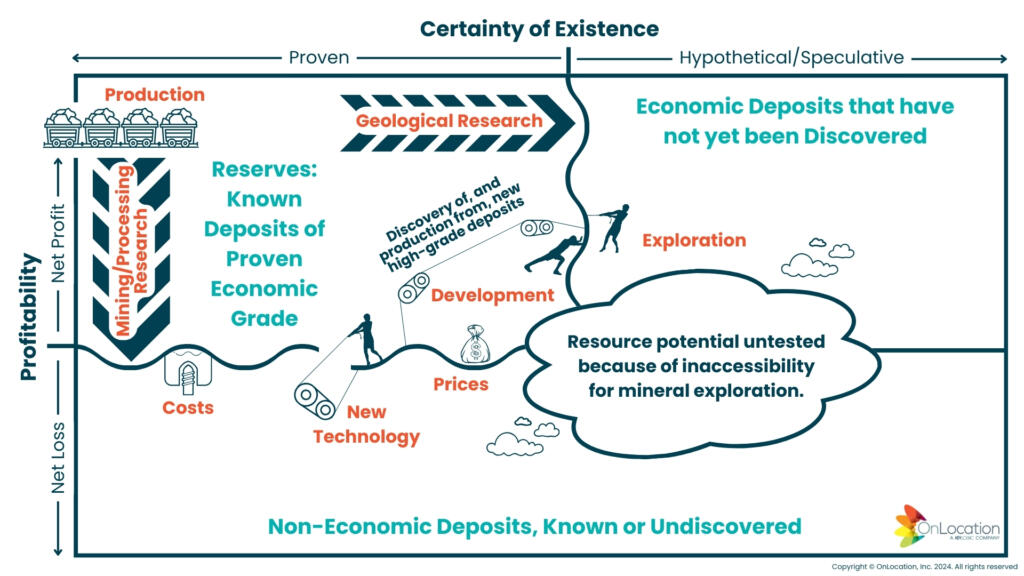Critical Mineral Resource Estimates Are Not a Fixed Number
The U.S. government through the Energy Act of 2020 defines critical minerals as any non-fuel mineral, element, substance or mineral material that has a high risk for supply chain disruption; serves an essential function in one or more energy technologies; and is significant to the economic or national security of the U.S.
Yet even this definition suggests that what is considered a resource can change, depending on circumstances.
In the transition of how energy is produced, transmitted, and consumed, there have been shifts in what resources are used – and may be critical for – the energy economy. OnLocation’s recent blog post, Batteries: An Essential Technology for the Energy Transition, discussed the emergence of critical materials in light of general U.S. demand, specifically for energy storage.
Resource Estimates Represent the Intersection of Geology, Technology, and Markets

Figure 1. Resources: Intersection of Geology, Technology, and Markets (Source: OnLocation, Inc.)
The nature of procuring these critical minerals is not straight forward, and is dependent on many outside factors, and on geographically distributed supply chains. The underlying economics of the resources themselves are a function of the interrelationships of geology, technology and markets, which ultimately affect supply, demand and price. For example, with lowering prices, the incentive for new investment declines, which can work to shrink supply, and depending on future demand, eventually affects price in one direction or the other. As these interactions play out, the quantity of estimated economic reserves will fluctuate with these cycles.
To determine the supply and demand for critical minerals requires varying levels of analysis. This is complicated by the fact that economic value may shift or disappear based on level of access to the resource, which are subject to policy changes or trade embargoes, given inherent geopolitical tensions and other factors. Demand is also influenced by technological innovations, and by products and economic expansion that require the input of a particular mineral. The nature of supply when it comes to minerals, in general, is predicated to some extent on the rate of production. With high production rates and ample supply, mineral prices tend to fall. Conversely, when production is low and demand is high, the price of a mineral will increase.
OnLocation’s expertise with NEMS includes working with variable amounts of resources in oil, natural gas, biomass, critical materials, and other forms of supply, and dependent upon these many different factors.
Technology’s Impact on Resource Estimates

Figure 2. Quantity of resources dependent upon many moving parts (Source: OnLocation, Inc., derived from U.S. Dept. of Interior)
The image shown above provides a visual framework for understanding concepts regarding resource estimates. It emphasizes that while proven reserves, which can often be directly calculated, are currently profitable and viable, the boundary of what constitutes a resource is not static. The potential of finding new deposits through exploration and development; the impact of new technologies on extraction and processing; and the fluctuation of mineral prices all play a role in the recalibration of what resources are considered critical.
Research in mining and processing technologies can increase the resource base, as illustrated, while increasing geological research can also increase resources as new discoveries are identified.
There are several processes that also affect resource estimates. For instance, new exploration “pulls” more potential areas under consideration as a resource, which may result in additional resources being recognized from those economic deposits that have not yet been discovered. Often, the very act of production of a resource results in more information to be obtained that “pushes” more resources to be recognized. New technology can essentially “mine” what is known to exist, but has previously been considered non-economic to produce, adding resources, which also has consequences for known and undiscovered resources.
Role of Markets in Determining Critical Mineral Resource Estimates
Markets play a key role in the total resource estimate for any material. Increased costs of extraction through changes in equipment, labor, and other costs can render higher-cost resources as non-economic, and vice versa, if any of those costs decrease. Likewise, if the demand for that commodity were to increase, which increases its price, then more marginal resources would be added to reserves and be produced. Thus, market-based drivers could transform today’s non-economic deposits into tomorrow’s critical resources – challenging the perception that mineral resources are a fixed number.
Understanding how the quantity of resources is estimated provides insight into how additional information, technology research, and supportive policies, can influence the perceived prevalence and ease of access to a particular resource. These individual resources taken together comprise the larger view of resources generally within a fully integrated economy.
To better understand the role production economics plays in resource estimates of critical minerals, OnLocation has developed a novel application of the National Energy Modeling System (CM-NEMS) and conducted an initial projection of critical materials demand for U.S. electric vehicles (EVs) to 2050. Read more about OnLocation’s critical minerals work by accessing our white paper here.

